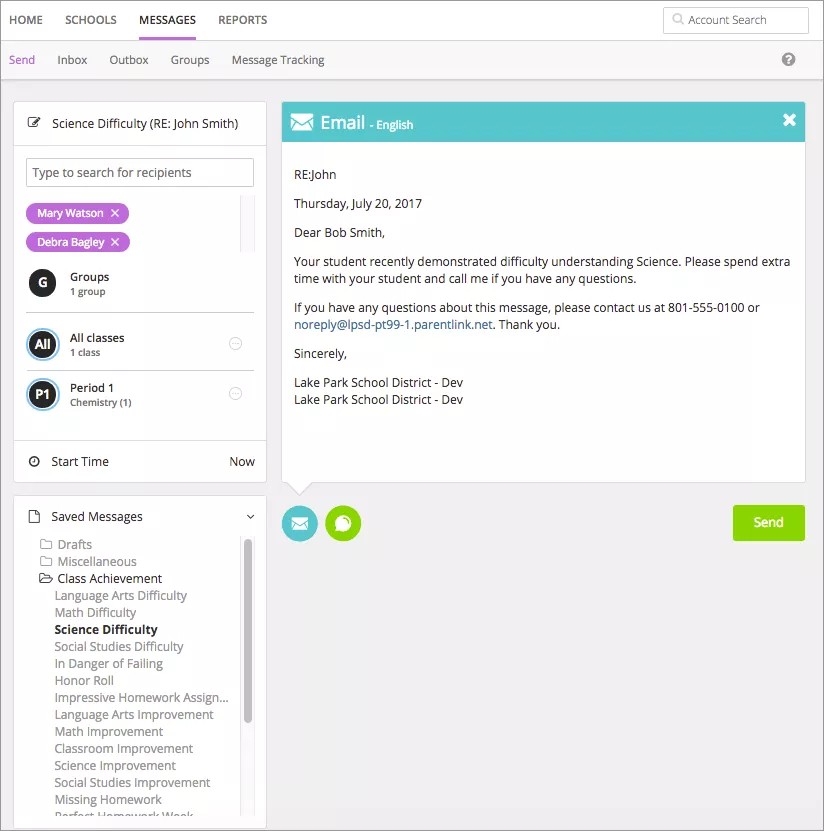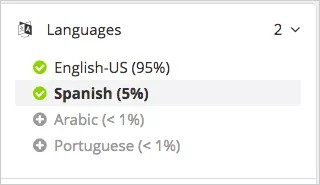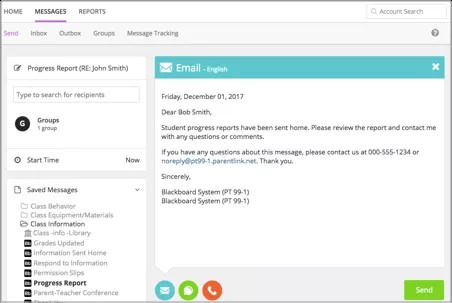Communicate effectively.
Your school's website includes a simple-to-use notification system that is designed for teachers — Teacher Communications. You can send messages to any of your students, the entire class, all your classes, or just to parents. Plus, Teacher Communications allows you to send pre-made messages. These messages are categorized into teacher specific categories and can be targeted to select students based on the message subject. You can also create your own message.
Check it out!
Send my own message
If you want to create your own message instead of sending a pre-made message, you can type your own content in Send Message page. You can then select to send it as an email, text/SMS message, or if set by your school, as a phone message.
- Select Messages.
Each teacher's students are separated into classes.
- Select the class or a user group.
Is there a group of students or parents that you contact on a regular basis? Create a special user group!
- To send a message to one or a few members, select the specific users. You can select all parents or all students, or use the list icon to select individual users. You can also search for specific users by name.
- Type the Subject.
- Select one or more delivery methods from the main send message page to send to the recipients:
- Emails - Type your text and add any images. To remove the email option, close out the tab from the upper right hand corner.
- Text/SMS - Content needs to be less than 160 characters. To copy content from the email message, select the Copy Content icon. To remove the text/SMS option, close out the tab from the upper right hand corner.
- Select Start Time to change the time to send the message. If you want to repeat message, you can also add more dates and times. You cannot send messages during your school's blackout times.
- Include language translations by selectingLanguage, and select each language needed.
You can remove any language with the Delete icon.
Amheric language will not include translation or text-to-speech capabilities. Some Android devices and iOS do NOT support Amheric, and the message may not look correct on those devices. However, it is expected that those users requiring Amheric language will use phones that support the display.
If needed, check the text message option if over the character limit.
- Select Send when finished.
Send a pre-made message
Pre-made messages allow you to quickly send standard, student-type messages to students in your classes or specific user groups you created. There are several you can choose from.
- System created: Written and recorded in four supported languages: English, Spanish, Portuguese, and Haitian-Creole. Can't be edited, copied, or deleted. Identified by the Blackboard logo.
- Admin created: Created by your district administrator. Can be copied only. Identified by an image of a building.
- User created: Written and recorded by a user. Can be edited, copied, and deleted. Identified by an image of a person.
All of the system pre-made teacher messages are available in several languages including English, Spanish, French, German, Mandarin, and Cantonese. Any of these messages will send in the preferred language of the recipient if available.
Messages will deliver at the optimal start time set by the school or district, and will also adhere to the school or district call window. Contact the school administrator about the teacher message delivery times at each school.
-
Select Messages.
Each teacher's students are separated into classes.
- Select the class or a user group.
- To send a message to one or a few members, select the specific users. You can select all parents or all students, or use the list icon to select individual users. You can also search for specific users by name.
- Select a message category from the Saved Messages list.
Category examples may include Class Achievements, Class Behavior, or Class Projects.
- Select the messages to use. The message will appear in the Send Message page.
- Type the Subject.
- Select one or more delivery methods from the main send message page to send to the recipients:
- Emails - You can update the text and add any images. To remove the email option, close out the tab from the upper right hand corner.
- Text/SMS - Content needs to be less than 160 characters. To remove the text/SMS option, close out the tab from the upper right hand corner.
- Select Send when finished.
What if I want to send a phone message?
By default, teachers cannot send phone messages unless the feature has been turned on by your district. If it is available, a phone icon will be available on the Send Message page. You can record audio to attach to your message. You can use your school's phone system to record the message, upload an audio file you created, or type text that will translate to speech. You select your recording option from the Phone list when creating a new message.
- If you select Call me to record, type your phone number and select Call me to record.
- If you select Call In to record, follow the on-screen instructions to record the message.
- Call the number listed.
- Immediately enter the unique four-digit code.
- Record the message after the prompt.
- Press pound # when finished.
- Select from the menu options:
- Press 1 to save the message.
- Press 2 to listen to the message.
- Press 3 to re-record the message.
- When satisfied with the message, press 1 and wait for the confirmation message before hanging up.
- If you select Upload Audio file, select Browse to find and upload your recorded audio file.
- If you select Text to Speech, type your message in the Text messages box. Select Play Audio to listen to the message, or type your phone number and select Call to hear your message.
Create accessible messages
创建可无障碍访问的消息
您知道吗,全球有 10 亿人具有精神或肢体方面的残疾。或者说,北美地区有 12.9% 的学生具有某种形式的残疾。确保所有学生和社区成员都理解交流信息非常重要。
适用于所有交流的无障碍访问最佳实践
无论是电子邮件还是 Facebook,利用这些无障碍访问最佳实践都可轻松访问消息。
- 简单写作。确保句子简短。尽可能使用 1-2 字节的字词或字词组合。使用缩写。使用 Hemmingway Editor 等工具确保文本的可读性。
- 请勿使用单独的字体样式或颜色来指示重要性!当您需要提供一个重要的视觉提示时,请确保使用无障碍替代方式。如果十分重要,则在句子末尾使用感叹号。屏幕阅读器会通过相应语调来表达感叹号和问号。这表示工具不会阅读“问号”,而是在大声阅读问题时发出询问语调。
- 在图像中提供替换文本。您无需描述“的图像”,因为辅助工具已经知道这是一张图像。尽量使用简洁、清楚的描述性文字。请勿为每张图像使用相同的替换文本,例如“说明相关文本的图像”。这毫无意义并且会导致杂乱。
- 无法添加替换文本时,添加图像标题。如果无法为图像添加替代文本,请确保您的文本不依靠图像便可传达所有信息。
- 使链接具有描述性。每个链接都应描述用户单击链接将找到的内容。避免使用通用语句,例如“单击此处”或“查看详情”。Web 地址或 URL 不会被视为信息,因此不得使用。而不是提供文本说明。
- 使附件可无障碍访问。遵循相同的最佳实践,使附件可无障碍访问。如需了解详细信息,请参阅 Blackboard 的无障碍访问。
- 为视频提供隐藏式字幕或脚本。如果您的视频不含隐藏式字幕,请提供指向脚本的链接。
- 尝试聆听消息,确保其听起来正确无误。使用大多数设备上提供的文字转语音工具聆听消息,然后再进行发送。
社交媒体中的无障碍访问
社交媒体不一定可无障碍访问。屏幕阅读器用户很难进行导航,而且内容不一定使用标题、图像替代文本或视频字幕。这并不意味着您无法使用社交媒体。这是您的受众面临的情况。确保您的内容尽可能实现无障碍访问,以适用于所有受众。
在使用 Facebook 或 Twitter 时,遵循适用于所有内容的 无障碍访问最佳实践及相关提示。
- 为您发布的所有照片和图像提供替代文本。
- 在发布视频时,提供指向脚本的链接。
- 向受众告知您的 Twitter 中的内容。如果您的 Twitter 中包含照片、视频或音频,请在 Twitter 的开始处使用以下前缀。
- 照片:[PIC]
- 视频:[VIDEO]
- 音频:[AUDIO]
- 在 Twitter 的结尾放置井号标记和说明。
- 在井号标记中使用驼峰字。对井号标记中的每个词采用首字母大写的形式。例如,#BlackboardAccessibility
- 避免使用在屏幕阅读器阅读时可能听起来奇怪的文字。




